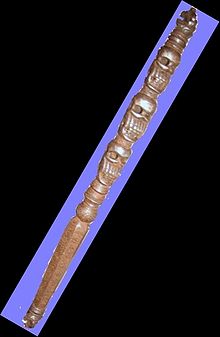Khatvanga
| Khatvanga | |
|---|---|

Khatvanga
|
|
| Devanagari | खट्वाङ्ग |
| Sanskrit transliteration | Khaṭvāṅga |
A khaṭvāṅga (Sanskrit: खट्वाङ्ग) is a long, studded club originally created as a weapon. It was adopted as a religious symbol in Indian religions such as Shaivism and Vajrayana Buddhism. The khatvāṅga was adopted by some lineages of historical tantra though it preceded such traditions.
In Hinduism, Shiva-Rudra carried the khatvāṅga as a staff weapon and are thus referred to as khatvāṅgīs.
Beer (2003: p. 102) relates how the symbolism of the khatvāṅga in Vajrayana, particularly the Nyingma school founded by Padmasambhava, was a direct borrowing from the Shaiva Kapalikas, who frequented places of austerity such as charnel grounds and crossroads as a form of "left-handed path" (vamachara) sādhanā.
The form of the Buddhist khaṭvāṅga derived from the emblematic staff of the early Indian Shaivite yogins, known as kapalikas or 'skull-bearers'. The kapalikas were originally miscreants who had been sentenced to a twelve-year term of penance for the crime of inadvertently killing a Brahmin. The penitent was prescribed to dwell in a forest hut, at a desolate crossroads, in a charnel ground, or under a tree; to live by begging; to practice austerities; and to wear a loin-cloth of hemp, dog, or donkey-skin. They also had to carry the emblems of a human skull as an alms-bowl, and the skull of the Brahmin they had slain mounted upon a wooden staff as a banner.These Hindu kapalika ascetics soon evolved into an extreme outcaste sect of the 'left-hand' tantric path (Skt. vamamarg) of shakti or goddess worship. The early Buddhist tantric yogins and yoginis adopted the same goddess or dakini attributes of the kapalikas. These attributes consisted of; bone ornaments, an animal skin loincloth, marks of human ash, a skull-cup, damaru, flaying knife, thighbone trumpet, and the skull-topped Tantric staff or khaṭvāṅga.
...
Wikipedia
